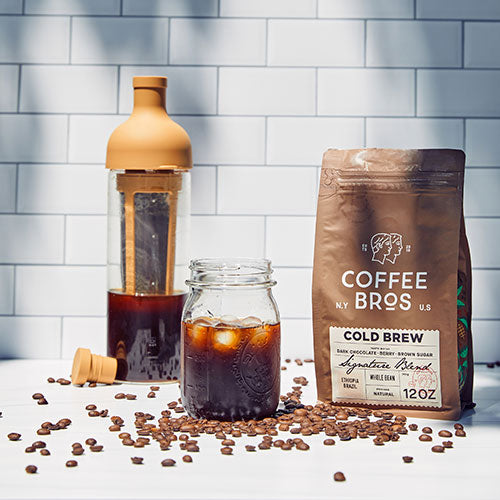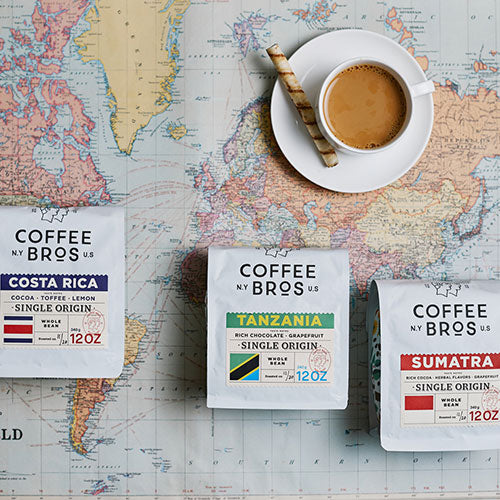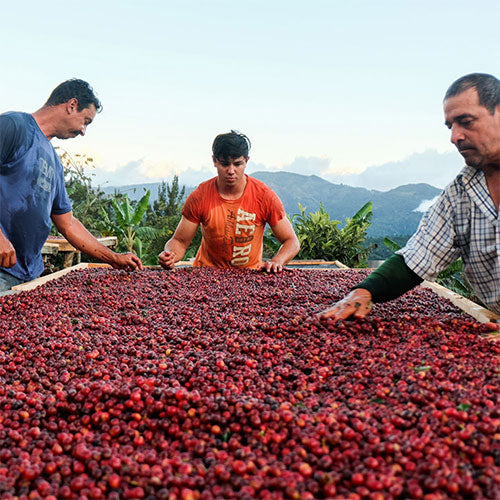Dark Roast Coffee for Super-Automatic Espresso Machines
Introduction
Super-automatic espresso coffee machines have complex internal designs, and certain coffee types are not ideal for brewing. We often get questions about dark and oily coffees and if they can be used within super-automatic espresso machines. We wanted to explain why you shouldn’t use dark and oily coffee in super-automatic espresso machines (or frankly ever) and suggest non-oily dark roasts that are perfect for super-automatic espresso machines.
Four types of espresso machines are on the market, defined by the effort needed to brew a tasty espresso.
Table of Contents
Coffee Subscription Deal
Subscribe to Coffee Bros. coffee for 25% off when using code "FTSUB25" at checkout
The four types of espresso machines
Manual espresso machines: Manual espresso machines require the most effort from the barista as you will control the brewing process from start to finish. A manual espresso machine would require you to grind, tamp, and extract the espresso manually and without any assistance from the machine itself. If you press a button to brew your espresso, you are not using a manual espresso machine. The barista is responsible for all brewing parameters with a manual espresso machine, from time, temperature, and flow rates.
A great example of a manual espresso machine would be the Flair 58, which requires the barista to apply the pressure needed to brew an espresso by pressing down on a lever. The force you create determines the level of pressurized water that gets pushed through the coffee puck. Manual espresso machines require much practice and can be somewhat inconsistent initially (practice makes perfect).
Manual espresso machines usually need more technology, such as changing the brewing temperature, preinfusion length, or any way to pressure profile. That said, there are commercial manual espresso machines on the market, like the La Marzocco Leva, which allows the barista to manually control the extraction by pulling down the lever. However, this machine is relatively modern and would not fall under the manual espresso category.
Semi-automatic espresso machines: Requiring less effort than the manual espresso machine, semi-automatic machines will still require the barista to grind, tamp, and extract the espresso, but a flip of a lever may activate the brew pump and extraction phase rather than manually pulling down on a lever.
Still, with a semi-automatic espresso machine, you, as the barista, are responsible for the brew’s time, temperature, and flow rates. The difference is that the machine will control the brewing pressure versus being a manual component with a manual espresso machine.
Semi-automatic espresso machines require the barista to stop the brew at the intended time or weight. The extraction is both activated and halted by the user with semi-automatic machines.
A great example of a well-priced semi-automatic espresso machine is the Rocket Espresso Appartamento.
The lack of almost any control on a super-automatic machine means you, the barista, have little influence over how the machine brews. For example, many super-automatic machines have no brew temperature control and often brew at much cooler temperatures than recommended for specific roast types.
Super-automatic machines also have a complex internal system since the grinding, compacting of the coffee, and brewing all occur within internal components. This means that users of super-automatic machines have little to no influence on grind size, tamping pressure, or even the amount of coffee being used; it is all preprogrammed based on the drink type you choose.
Since super-automatic espresso machines have complex internal systems, the type of coffee you choose to brew is extremely important (more on that below). Further, the lack of temperature control, grind size, and tamping pressure in a super-automatic machine means you must carefully choose what coffee you brew.
Manual espresso machine
Semi-automatic espresso machine
Automatic espresso machine
Super-automatic espresso machine
How super-automatic espresso machines work
As mentioned earlier, super-automatic espresso machines handle the grinding, tamping (compressing), brewing, and steaming of milk all within the internal system. Unlike manual, semi-automatic, and automatic espresso machines where you place a portafilter into a group head to brew, the super-automatic machines handle this all internally.
A super-automatic machine will go through the following process
- A user selects their drink on the super-automatic espresso machine screen.
- The coffee is ground in an integrated espresso grinder.
- The espresso grounds are then pushed into a brewing chamber.
- The ground coffee gets compressed in the brewing chamber. Think of this step as the tamping step when brewing using other machines.
- The super-automatic espresso machine then pushes a small amount of hot water into the brewing chamber to saturate the espresso puck.
- Once preinfusion has been completed, and depending on the drink choice, the remaining hot water flows through the espresso puck at standard pressure and out the coffee spout.
- The super-automatic machine then goes through a cleaning phase where it squeezes the remaining water out of the espresso puck, disposes it into the drip tray, then pushes the ground coffee out of the chamber and flushes the system with hot water.
A few nuances about super-automatic espresso machines will influence the type of coffee you should buy and brew with.
- Temperature: Most super-automatic machines have one standard brewing temperature, which is usually very cool (much cooler than ideal coffee brewing temperatures).
- Grind size: The user has no control over the grind size of the coffee. If you brewed on any other espresso machine type, you understand how impactful the proper grind size is in espresso extraction. Incorrect grind size can create a more sour or bitter-tasting cup of coffee.
- Internal components: Since all the brewing happens internally, it will be difficult to clean your machine properly, so avoiding extremely oily coffee is highly advised.
Choosing a coffee for a super-automatic espresso machine
While super-automatic machines score high on their ease of use and design, they struggle to brew a wide range of coffees due to the lack of temperature control, grind size variability, and a complex internal system that is difficult to clean.
Research shows that most high-end super-automatic espresso machines brew far cooler than most coffee experts recommend.
Here is a table displaying the beverage temperatures of several of the top super-automatic espresso machine makers
| Super-automatic espresso machine maker | Beverage Temperature |
| Delonghi | 68 - 74°C |
| Saeco | 70 - 71°C |
| Philips | 70 - 71°C |
| Gaggia | 70 - 71°C |
| Jura | 69 - 70°C |
| Melitta | 69 - 70°C |
| Bosch | 69 - 70°C |
| Nivona | 69 - 70°C |
*Thanks to Dmitriy Yurchenko for this research on the article: Espresso temperature when using super-automatic machines
While the above displays the beverage’s temperature right after brewing, it gives a fair estimation that the brew temperature will not be too far off from what is seen immediately in the cup.
If we look at the recommended brewing temperatures by roast type, we will see that super-automatic machines are far from what we recommend for espresso brewing.
| Roast Type | Optimal Brewing Temp (Celsius) | Optimal Brewing Temp (Fahrenheit) |
| Light | 93 - 96°C | 199 - 205°F |
| Medium | 90 - 93°C | 194 - 200°F |
| Dark | 87 - 90°C (even cooler works) | 188 – 194°F |
Super-automatic espresso machines will limit the types of coffees you should use due to the cooler temperatures, and darker roasts will work the best. We’ll dive into what to watch out for when purchasing dark-roasted coffee for your super-automatic machine, as not every dark roast will work for these machines.
The grind size of super-automatic machines is also coarser than the ideal grind size when brewing espresso due to how the machine is built.
- Super-automatic machines have a complex internal system where coffee grounds run from start to finish. Suppose super-automatic machines use extremely finely ground coffee, as recommended for espresso brewing. In that case, the internal systems will gunk up more frequently as it is difficult to clean these systems properly.
Knowing that super-automatic espresso machines use a coarser grind and brew at very cool temperatures, purchasing a coffee with high or complex acidity, like what you might find in a single-origin light roast, will not work well in these machines.
The ideal coffee for super-automatic machines tends to fall on the darker side as cooler temperatures and coarser grinds work well with darker coffees.
Why dark oily coffee doesn't work in super-automatic espresso machines
Dark oily coffee can wreak havoc on the internal system of super-automatic machines due to their oily exterior, which can build up over time, impacting future brews. If you watched the video under the section “How super-automatic espresso machines work,” you will see how the ground coffee passed into a brewing chamber and, once brewed, the puck is pushed out into a waste bin. When using an oily dark roast, the oils will create a film within the brewing chamber which is challenging to remove with the machine’s standard cleaning process. These oils, over time, can become rancid, which impacts subsequent brews in your machine.
Further, the same will occur in the grinder and on or around the conical burrs within the system. If you are not comfortable cleaning the grinder of your super-automatic machines, these oils will also build up over time in the grinder.
The above reasons are why most super-automatic machine manufacturers explicitly tell their customers not to use dark oily coffee in their machines.
The best dark roast coffee for super-automatic espresso machines
Until now, we broke down the key differences between super-automatic espresso machines and their counterparts (manual, semi-automatic, and automatic), as well as explained how they were and some of the flaws of the machines, such as their brewing temperatures and grind size.
We also recommended using dark-roasted coffees in these machines but advised against using any dark-roast coffee that spots oils, so now what!
Luckily, we have great recommendations for the best dark roast coffee for super-automatic espresso machines, and we roast them fresh every week.
We have two dark-roasted coffees that work exceptionally well with super-automatic machines as they are both extremely rich, bold, and not acidic, or bitter. Most importantly, they aren’t covered in oils that can damage your machine over time




